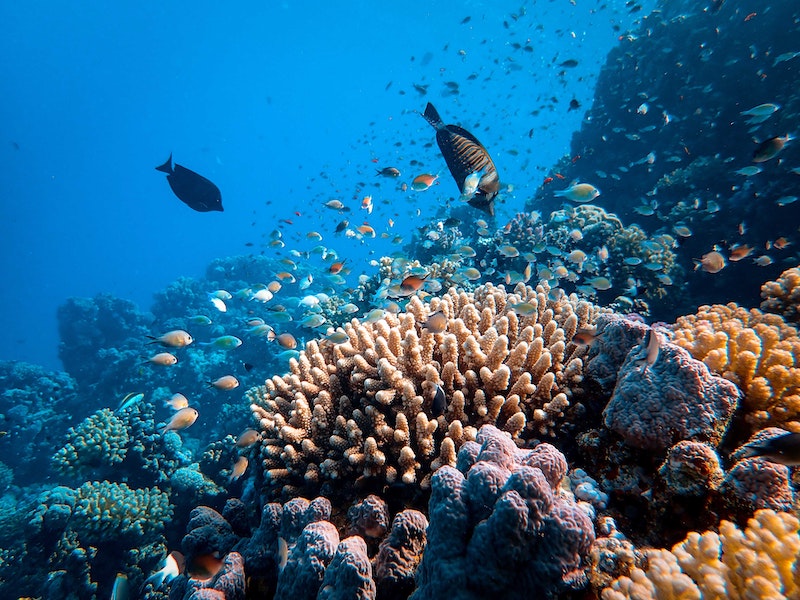As we see more brands start selling reef-safe sunscreen, it’s reasonable to wonder what exactly makes a sunscreen reef safe?
Is “reef-safe” a legitimate term? Or is it just a marketing gimmick? We’ll dive into it all and explain what categorizes a sunscreen as reef-safe here!
The dangers of using non-reef-safe sunscreens
When sunscreen washes off in the water, it can cause a lot of damage to delicate coral reefs.
Many of the ingredients in conventional chemical sunscreens (the most common type of sunscreen) are toxic to coral reefs as well as other marine life, and even small amounts can have devastating effects.
According to the National Park Service, up to 6,000 tons of sunscreen enters coral reef areas each year.
Oxybenzone and octinoxate are two common ingredients found in chemical-based sunscreens that have been shown to be particularly harmful to reefs. These chemicals can cause coral bleaching – a process in which coral expels the algae living in their tissues and turn white.
In this state, the coral is still alive, but severely weakened. In this bleached condition, coral is more susceptible to damage from storms and other stresses, greatly affecting the health of the entire coral reefs.

How do you know if sunscreen is reef-safe?
In truth, there is no legislative body or official definition on what constitutes “reef-safe sunscreen.” Generally, sunscreens are marketed as “reef-safe” if they do not contain oxybenzone and octinoxate, which are known dangerous ingredients for coral.
However, no sunscreen has been proven to be completely safe for coral reefs and marine life. There are still a host of other ingredients, from fragrances and preservatives, to chemicals and minerals, that could potentially damage delicate coral reefs.
What ingredients make a sunscreen reef-safe ?
There are a few key ingredients to look for in reef-safe sunscreen are zinc oxide, titanium dioxide.
Zinc oxide and titanium dioxide are minerals that provide physical sun protection by sitting on top of the skin and reflecting UV rays away before they can penetrate and damage the skin.
The best way to protect coral reefs is to use physical sunscreens with these minerals, as these types of sunscreens are less likely to wash off in the water and aren’t absorbed by coral reefs. This is also why you’ll often see a white cast on your skin with physical sunscreen
When selecting a sunscreen that’s safe for reefs, you’ll also want to look for the label “non-nano” on the sunscreen. Nano particles are tiny particles that can be easily absorbed by the skin, eliminating white caste, but also making those particles absorbable for reefs – which we don’t want.
Does reef-safe sunscreen really help?
Sunscreen isn’t the only threat to reefs; scientists also point to climate change, overfishing and pollution as major contributors to the declining health of coral reefs and other marine life.
It’s also worth noting that studies evaluating the toxicity of oxybenzone and octinoxate towards reefs has only been performed in a laboratory setting. Some experts have noted that the real-life levels of these chemicals – even on popular beaches with many swimmers and surfers – is too low to cause any obvious distress to the reefs.

Still, that isn’t to say that even this lower levels of exposure won’t hurt coral reefs, especially over time. And if we know that certain chemicals have the potential to hurt our oceans, and we have plenty of sunscreen options that avoid those chemicals, why not embrace the reef-safe sunscreens?
How to keep reefs safe
- Wear sun protective clothing. Wearing sun shirts, sun hats, and sun protective shawls can reduce your need to frequently reapply sunscreen, therefore helping protect the environment. Of course you don’t need to sacrifice your skin, but using sun safe clothing can dramatically reduce the amount of sunscreen you need to stay safe and the frequency with which you’d need to apply it.
- Choose a physical, mineral sunscreen. Physical, mineral sunscreens that use ingredients like zinc oxide or titanium dioxide are not shown to negatively affect coral reefs.
- Look for “non-nano” on the label. Nano particles are small particles of titanium dioxide and zinc oxide that can more easily absorbed by the skin, eliminating the problem of white caste. Unfortunately, because these particles are so small, they’re also more likely to be harmful to marine life. Whereas standard non-nano zinc oxide sunscreen and titanium dioxide formulas are safe, nano formulas are not, with the potential to hurt the reefs.
- Avoid oxybenzone and octinoxate. While we don’t know everything about how all sunscreens affect the environment, these sunscreen ingredients specifically have been shown to cause coral bleaching, so look for formulas without them.
- Use a lotion sunscreen. Lotion sunscreens are less likely than spray sunscreens to spread into the air and water.
- Wait before swimming. If you jump into the water too early before your sunscreen has a chance to fully absorb or attach to your skin, it’s more likely to wash off and get into the water.
As you can see, what makes sunscreen reef safe largely depends on the sunscreen’s ingredients and composition (namely, avoiding oxybenzone and octinoxate, opting for non-nano formulas, and choosing lotion over spray).
Have you ever used reef-safe sunscreen? Did it feel different than traditional sunscreen? Let us know in the comments!

